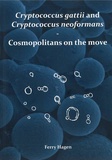Cryptococcus gattii and Cryptococcus neoformans
Cosmopolitans on the move

Hagen, Ferry
- Promoter:
- Prof.dr. A.I.M. (Andy) Hoepelman
- Co-promoter:
- Dr T. (Teun) Boekhout
- Research group:
- Hoepelman
- Date:
- October 25, 2011
- Time:
- 14:30 h
Summary
The fungal pathogens Cryptococcus neoformans and Cryptococcus gattii are the leading cause of fungal meningitis worldwide. Until three decades ago both pathogenic yeast species were, however, rarely encountered. The onset of the HIV-pandemic during the early 1980s showed the deadly potential of the opportunist C. neoformans among HIV-infected individuals. Recently, it has been estimated that annually approximately one million HIV-positive patients develop cryptococcal meningitis, resulting in 625.000 fatalities. This made C. neoformans one of the leading causes of death, followed by tuberculosis, in HIV-patients from sub-Saharan Africa. However, not only immunocompromised individuals are threatened, as shown by unprecedented emergence of the primary pathogen C. gattii that causes expanding outbreaks in the temperate climate of British Columbia (Canada) and the Pacific Northwest of the United States. The application of molecular biological techniques in the field of cryptococcal epidemiology revealed that previously observed epidemiological differences between C. neoformans and C. gattii are much less black and white than previously assumed. Within both species genotypes exist that infect immunocompetent or immunocompromised individuals. Examples are the occurrence of C. gattii as the cause of cryptococcosis among HIV-infected patients in Africa and C. neoformans variety grubii infections among apparently healthy Chinese individuals. Subtle epidemiological differences seem to exist, and this is particularly visible between the current genotypes rather than between the species C. neoformans and C. gattii. Thus the advance of molecular biology has clearly shown that the current taxonomy of C. neoformans and C. gattii needs a thorough revision. The aim of this thesis was to investigate the epidemiology and population biology of the two major fungal pathogens Cryptococcus neoformans and Cryptococcus gattii and thereby provide additional support for a future taxonomic reappraisal of the species complex. Both species are investigated using a comprehensive set of molecular epidemiological tools combined with diverse phenotypic assays to further unravel the geographic and genetic origin of enhanced virulence. This thesis consists of three sections: Section 1 contains the Chapters 2, 3 and 4 that focus on the epidemiology of C. neoformans in Croatia, the Netherlands and Spain, respectively. Section 2 includes chapters 5, 6 and 7 that focus on the epidemiology of C. gattii. Section 3 comprises the Chapters 8, 9, 10 and 11 that are all dedicated to the epidemiological and clinical aspects of the C. gattii outbreak in North America.